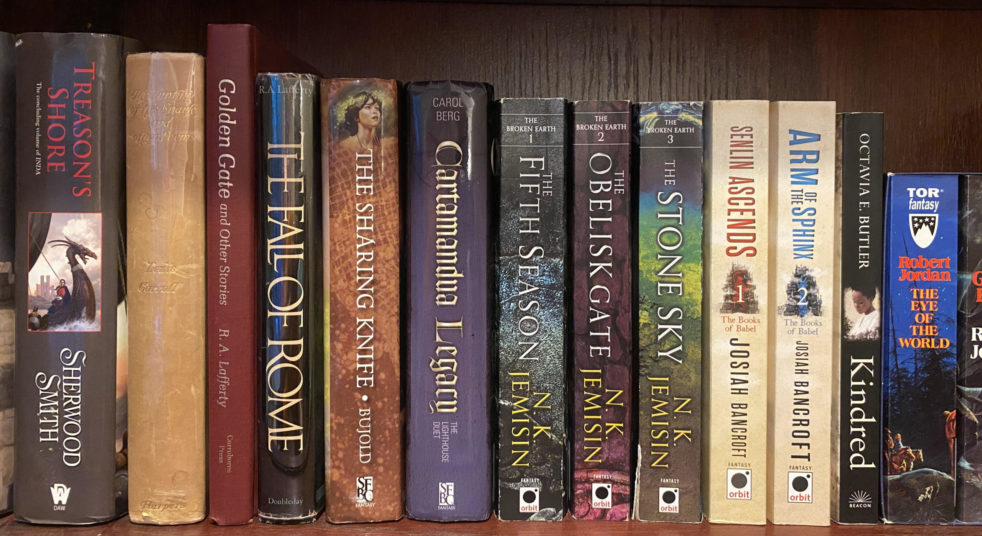
T. Kingfisher has been popular for a while, but her popularity has grown immensely in the last two years, where her Hugo wins for Best Novella and Best Novel has made her just the fourth person ever (and second named Ursula) to win Hugos in the Novel, Novella, Novelette, and Short Story categories. She also has a Lodestar and Graphic Story win. So yeah, much loved! While I really enjoy her work for younger audiences, I’ve started wearing out a little bit on her (extremely prolific) adult releases, so I skipped A Sorceress Comes to Call to give myself a bit of time away from her writing before I inevitably picked it back up in my Hugo reading.
A Sorceress Comes to Call is split between two main perspective characters. Cordelia is the young daughter of a terrifying sorceress with the power to force complete bodily obedience. Her mother has mostly scraped by on the generosity of possibly-bespelled lovers, but when spurned by her latest, she decides to look for a husband, bringing mother and daughter to call at the home of a wealthy, middle-aged squire. But the squire’s sister Hester sees something wrong from the outset and is determined not to let doom fall on her brother and his household at the hand of this strange new woman.
While Kingfisher writes in a number of subgenres, one of her favorites is the fairy tale space—with A Sorceress Comes to Call loosely inspired by the Goose Girl, with some regency-style romance thrown in for good measure—and my critiques tend to be pretty similar from book to book. The opening is usually strong, drawing the reader in and hinting at layers of darkness to follow. But the leads will inevitably assemble a small group of quirky, bantering adventurers who solve the problem in a way that feels just a little too light for the tone established in the first quarter. And while that critique holds for A Sorceress Comes to Call, this one has some real strengths that has made it my favorite of Kingfisher’s adult fairy tales.
For me, the strength of A Sorceress Comes to Call is easily the first third, introducing Cordelia as an abused child absolutely terrified by her mother but with no way out. Her perspective is immersive and claustrophobic, and I’ve seen more than a few reviewers point out that it could’ve felt right at home in a horror story. Instead, this is a fairy tale, but this sort of darkness is well-represented in fairy tales as well, and the first half of the book strikes an absolutely perfect tone. Hester’s sarcasm adds a bit of levity, but she’s an entertaining character in her own right and is sufficiently worried about her brother to keep things from getting too comic. The first half of the book is truly Kingfisher at the height of her powers.
But, as I find so commonly in Kingfisher’s work, the cast expands and the tone lightens in the second half. Hester invites a few old friends and enlists some of the help to try to sort through exactly what the danger is and what can be done about it, and by and large, the assembled band consists in people a little more straight-laced than Hester herself. There is one clear exception, but the intensity of the fears from Hester and Cordelia are largely able to keep the tone in balance in the early part of the second half. But in the final third, the story introduces another supernatural element beyond the titular sorceress, and that new dimension provides a significant push in a lighter direction. It’s the sort of thing I expect in every Kingfisher fairy tale, so I don’t imagine it will be an obstacle to her fans, but for me, it throws off the tonal balance and brings the overall work from true excellence into a good-but-flawed zone.
In fairness, it does pull together for a thrilling ending that I didn’t want to put down. The intensity of the dangers bring back some of the narrative heft and ratchet up the tension for an engrossing finish. I might’ve liked for Cordelia to be a pinch more active, but she isn’t sufficiently sidelined to make it a major criticism, and the ending remains both gripping and satisfying. For a book that was starting to wobble, it was enough to recover and send the tale out on a high note.
On the whole, A Sorceress Comes to Call provides roughly what you’d expect for a Kingfisher fairy tale. It should thrill her fans but likely won’t win over her critics. For me, the character work in the setup provides some of the best I’ve seen in Kingfisher’s adult work, and while the tone lightens a bit too much for my taste in the final third, the highs are sufficiently high and the ending is sufficiently gripping to make this a quality read.
Recommended if you like: T. Kingfisher, feminist fairy tale retellings heavy on the banter.
Can I use it for Bingo? It’s hard mode for Parents and High Fashion, and it’s a Book Club selection.
Overall rating: 16 of Tar Vol’s 20. Four stars on Goodreads.
